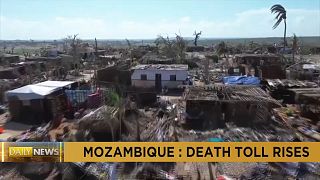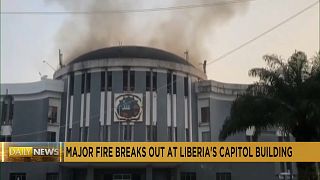Tonga
U.N. Secretary-General Antonio Guterres issued yet another climate SOS to the world, highlighting seas that are rising at an accelerating rate, especially in the far more vulnerable Pacific island nations.
This time he said those initials stand for "save our seas."
The United Nations and the World Meteorological Organization Monday issued reports on worsening sea level rise, turbocharged by a warming Earth and melting ice sheets and glaciers.
They highlight how the southwestern Pacific is not only hurt by rising water levels, but by other climate change effects of ocean acidification and marine heat waves.
Guterres toured Samoa and Tonga and made his climate plea from Tonga's capital Nuku'alofa on Tuesday at a meeting of the Pacific Islands Forum, whose member countries are among those most imperilled by climate change.
Next month the United Nations General Assembly holds a special session to discuss rising seas.
“This is a crazy situation,” Guterres said. “Rising seas are a crisis entirely of humanity's making. A crisis that will soon swell to an almost unimaginable scale, with no lifeboat to take us back to safety.”
“A worldwide catastrophe is putting this Pacific paradise in peril,” he said. “The ocean is overflowing.”
A report that Guterres' office commissioned found that sea level lapping against Tonga's capital Nuku'alofa had risen 21 centimeters (8.3 inches) between 1990 and 2020, twice the global average of 10 centimeters (3.9 inches). Apia, Samoa, has seen 31 centimeters (1 foot) of rising seas, while Suva-B, Fiji has had 29 centimeters (11.4 inches).
“This puts Pacific Island nations in grave danger,” Guterres said. About 90% of the region's people live within 5 kilometers (3 miles) of the rising oceans, he said.
Since 1980, coastal flooding in Guam has jumped from twice a year to 22 times a year. It's gone from five times a year to 43 times a year in the Cook Islands. In Pago Pago, American Samoa, coastal flooding went from zero to 102 times a year, according to the WMO State of the Climate in the South-West Pacific 2023 report.
“Because of sea level rise, the ocean is transforming from being a lifelong friend into a growing threat,” Celeste Saulo, secretary-general of the World Meteorological Organization, told reporters in Nuku’alofa on Tuesday.
While the western edges of the Pacific are seeing sea level rise about twice the global average, the central Pacific is closer to the global average, the WMO said.
Sea levels are rising faster in the western tropical Pacific because of where the melting ice from western Antarctica heads, warmer waters and ocean currents, UN officials said.
Guterres said he can see changes since the last time he was in the region in May 2019.
While he met in Nuku'alofa on Tuesday with Pacific nations on the environment at their leaders' annual summit, a hundred local high school students and activists from across the Pacific marched for climate justice a few blocks away.
One of the marchers was Itinterunga Rae of the Barnaban Human Rights Defenders Network, whose people were forced generations ago to relocate to Fiji from their Kiribati island home due to environmental degradation. Rae said abandoning Pacific islands should not be seen as a solution to rising seas.
“We promote climate mobility as a solution to be safe from your island that’s been destroyed by climate change, but it’s not the safest option,” he said. Barnabans have been cut off from the source of their culture and heritage, he said.
“The alarm is justified,” said S. Jeffress Williams, a retired U.S. Geological Survey sea level scientist. He said it's especially bad for the Pacific islands because most of the islands are at low elevations, so people are more likely to get hurt. Three outside experts said the sea level reports accurately reflect what's happening.
The Pacific is getting hit hard despite only producing 0.2% of heat-trapping gases causing climate change and expanding oceans, the UN said. The largest chunk of the sea rise is from melting ice sheets in Antarctica and Greenland. Melting land glaciers add to that, and warmer water also expands based on the laws of physics.
Antarctic and Greenland “melting has greatly accelerated over the past three to four decades due to high rate of warming at the poles,” Williams, who was not part of the reports, said in an email.
About 90% of the heat trapped by greenhouse gases goes into the oceans, the UN said.











02:19
UN Climate deals criticized for slow progress and uncertain outcome
00:51
UN chief praises Lesotho for its investments in green energy
01:16
António Guterres' vision for climate justice in Africa's G20 leadership
02:10
COP29: A $300B a year deal for climate cash sparks outrage
01:20
COP29 summit: Anger at ‘meagre’ figure for climate cash
01:45
COP29: Delegates renegotiate new compensation for developing nations